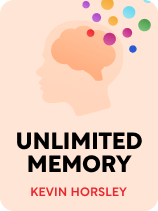

This article is an excerpt from the Shortform book guide to "Unlimited Memory" by Kevin Horsley. Shortform has the world's best summaries and analyses of books you should be reading.
Like this article? Sign up for a free trial here.
How much do we learn through association? What are good association learning techniques?
According to Unlimited Memory by Kevin Horsley, we learn everything by association. Association is when you make mental connections between the knowledge you already have and the knowledge you’re trying to learn.
Continue reading for techniques that improve your association skills.
Association: Connecting What You’re Learning to What You Know
When you learn through association, you’re using your long-term memory (things you already know well) to latch onto items that are passing through your short-term memory. This allows you to store them in your medium-term memory (which ultimately becomes your long-term memory). This is how you make new information accessible to your brain.
(Shortform note: In The Brain That Changes Itself, Norman Doidge explains that creating mental associations actually causes physical changes in the brain through a phenomenon known as neuroplasticity. When you have a thought or learn something new, a neural pathway between nerve cells in your brain forms, and the more you have that same thought or remember that information, the stronger the pathway (and its respective mental association) gets. This also means that the less you use a pathway, the weaker that pathway becomes, which highlights the importance of review and practice as we’ll see later in this guide.)
For example, when you meet someone for the first time, their name is new information. When they tell you their name, it will go into your short-term memory, and unless you make a deliberate effort to create an association between that name and some other information that’s already in your long-term memory, it will fade from your short-term memory within seconds. If you meet someone named Julie, for example, you may look closely at her face and imagine her covered in jewels to help you remember the sound of her name. This will shift her name from your short-term memory to your medium-term memory, and revisiting that association will eventually push the information into your long-term memory.
(Shortform note: The “terms” in short-term, medium-term, and long-term memory refer to different timespans: Information stays in your short-term memory for less than a minute, and once it’s consolidated into long-term memory, it can last forever. Medium-term memory lasts for a few hours, which means you’ll need to strengthen that association enough within those few hours to make it stick in your long-term memory. If you learn a name and create an association, but you don’t refresh your memory of that association until the next day, it’s likely that you’ll have already forgotten it. Be aware of the different lengths of your different types of memory so you can review new information at the best times.)
The more knowledge you have, the easier it is to take in new knowledge because there’s more to connect it to. The methods for memorization that Horsley describes are all based on associative learning. These methods include the SEE method for remembering any information, as well as tips for organizing your memories and specific advice on how to remember lists through pegging information.
1. The SEE Method
To help you create such associations and make any piece of information easier to learn, Horsley recommends the SEE method. SEE stands for Senses, Exaggeration, and Energize. The SEE technique helps you make information more meaningful, and meaningful information is easier to remember than meaningless information. These three strategies can be used in any order, but Horsley recommends using all three for any piece of important information you want to remember.
Senses: Your five senses are your means of perceiving—and thus learning about—the world. Creating an association between information and your senses automatically makes it more memorable. You can use your senses to make sensory images in your mind that will make information more real and accessible to your brain. For example, say you’re trying to memorize musical terms like forte, allegro, and octave. Forte means strong and loud, and a fort is a strong structure, so create a sensory image by picturing someone standing on top of a fort (visual image) yelling loudly (auditory image) to be heard from the ground.
Exaggeration: As you’re creating your sensory associations, make them ridiculous or illogical to make them stick in your memory better. It’s easier to remember a cat the size of a thimble than a regular-sized cat, for example, or to remember a man with a neon-green mustache than a man with a mustache of a regular color. Returning to our musical terms example: Allegro means fast and lively and sounds like “leg,” so imagine a pair of legs growing comically long, like the size of skyscrapers, so they walk faster.
Energize: Once you have your exaggerated sensory images, animate them. Creating action in your images helps you turn them into a narrative, and it’s easier to remember action than nonaction. To illustrate this, consider our final musical term: octave. Octave means a range of eight notes, and an octopus has eight tentacles, so imagine an octopus animatedly playing a piano and hitting eight notes at once.
2. Creating Organized Memories
Another associative technique that Horsley describes is organizing your memories so they’re easier to retain. He recommends strategies in which you associate new pieces of information with things you already know well. For example, imagine you’re trying to memorize the eight primary emotions according to Robert Plutchik: joy, sadness, fear, anger, anticipation, surprise, disgust, and trust. We’ll use a home as our reference point.
Since there are eight things we’re trying to remember, we’ll identify eight places in a typical home that we can associate each word with: the computer, television, closet, dryer, oven, refrigerator, trash can, and thermostat. Now you’ll use the SEE method to create a clear image you can associate with each emotion.
- Imagine yourself happily scrolling through adorable cat pictures on social media, or gleefully purchasing a huge bouncy house online: Your computer represents joy.
- Think of the most heartbreaking movie or show you’ve ever seen and imagine yourself crying giant tears like a cartoon character: Your television represents sadness.
- Think about a huge, terrifying, growling monster hiding in your closet: Your closet represents fear.
- Imagine an angry little fairy getting tossed around and around in your dryer, getting more and more furious: Your dryer represents anger.
- Think about waiting excitedly in front of your oven for a big batch of cookies to finish baking: Your oven represents anticipation.
- Imagine yourself going to your refrigerator and finding it unexpectedly filled with flavorful, colorful dishes from many different cuisines. Your refrigerator represents surprise.
- Imagine going to your trash can and finding it overflowing with rotten food, smelling like a landfill. Your trash can represents disgust.
- Think about adjusting your thermostat, and imagine a giant thermometer with the temperature moving up and down. Consider how you don’t actually know the exact temperature of your home by any other means; you just have faith that the thermostat is correct. Your thermostat represents trust.
According to Horsley, organizing knowledge as you take it in is the best way to learn and memorize it. Every new piece of information you’re trying to memorize (the emotions) is being connected to information that’s already in your long-term memory (areas of your home).
This organizational technique involves a four-step process:
- Identify the organizational reference tool you want to use, such as your car, your body, a place you know well, or a journey or route.
- Identify places in these reference tools where you can place associations.
- Create distinctive images of each piece of information you’re learning using the SEE method.
- Assign each piece of information to one of the places you identified in step 2.
3. Remembering Lists and Numbers
Horsley also offers a specific associative technique to help you remember lists of items or terms. Horsley recommends the pegging method for remembering these. This involves assigning meaningful words to numbers and then associating those words with each list item. For example, if you want to remember the three states of matter—1) solid, 2) liquid, and 3) gas—you could use the following associations: “One” rhymes with “gun,” which is a solid object, so the first item on the list is “solid.” “Two” rhymes with “dew,” which is a liquid, so the second item on the list is “liquid.” “Three” rhymes with “breeze,” which refers to gases (like oxygen and carbon dioxide) in motion, so the third item on the list is “gas.”
You can make links based on the numbers’ physical shapes (like associating zero with an egg or eight with a pair of glasses) or based on words that rhyme with the numbers (like associating two with glue or nine with wine).
(Shortform note: This system requires making two separate lists: One list is for the numbers themselves and the words you’re associating them with (like “one” and “gun” or “zero” and “egg”), and the other list is the list you’re using this peg system to memorize (like the three states of matter, or whatever other concept you need to remember). However, you may only need to make the first list once, as you can reuse it as many times as you want to memorize additional content. As you’re first starting out, be sure to take in the information slowly, as it takes a while to get the hang of it—but the more you use it, the faster you’ll get.)
This technique works well for remembering numbered lists, but you can also use it to remember numbers themselves. Horsley uses a pegging system to associate numbers with consonant sounds based on how they look (vowel sounds are excluded from this and act as filler). He codes “one” as the “T” sound, for example, because the letter and the number look similar. He codes “two” as the “N” sound, “three” as the “M” sound, “four” as the “R” sound, and so on. Thus, if you needed to remember the number 124, you could remember it as the word “tuner,” “toner,” or “tinier.” Thus, by turning numbers into words and sentences, you can remember as many numbers and number sequences as you need to.
(Shortform note: This number technique is a variation on the pegging system known as the major system. You can use this system to create pegs for just the numbers zero to nine or expand beyond that into double and even triple-digit numbers according to your needs. Some memory athletes use a set of 1,000 pegs so they can memorize very long numbers. You can adopt the traditional major system or make your own, and you can also use variations of this system to remember things like dates of events.)

———End of Preview———
Like what you just read? Read the rest of the world's best book summary and analysis of Kevin Horsley's "Unlimited Memory" at Shortform.
Here's what you'll find in our full Unlimited Memory summary:
- Why there's no such thing as a bad memory
- How anyone can train their brain to learn and remember anything
- Memory association techniques and how to use them






